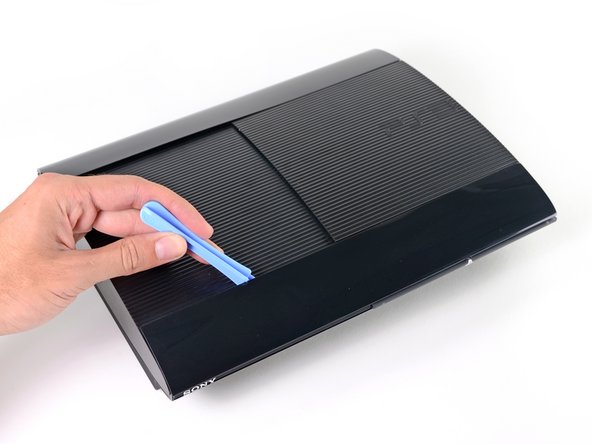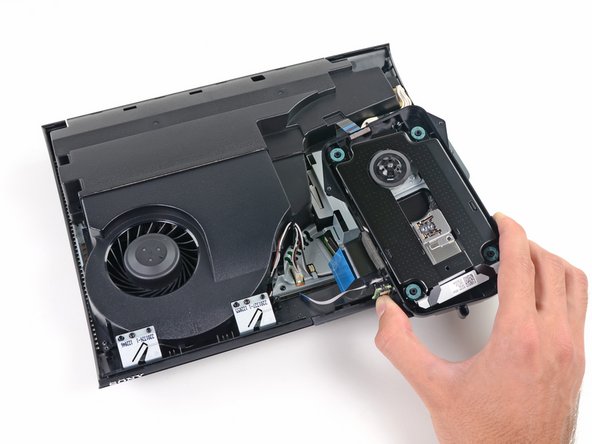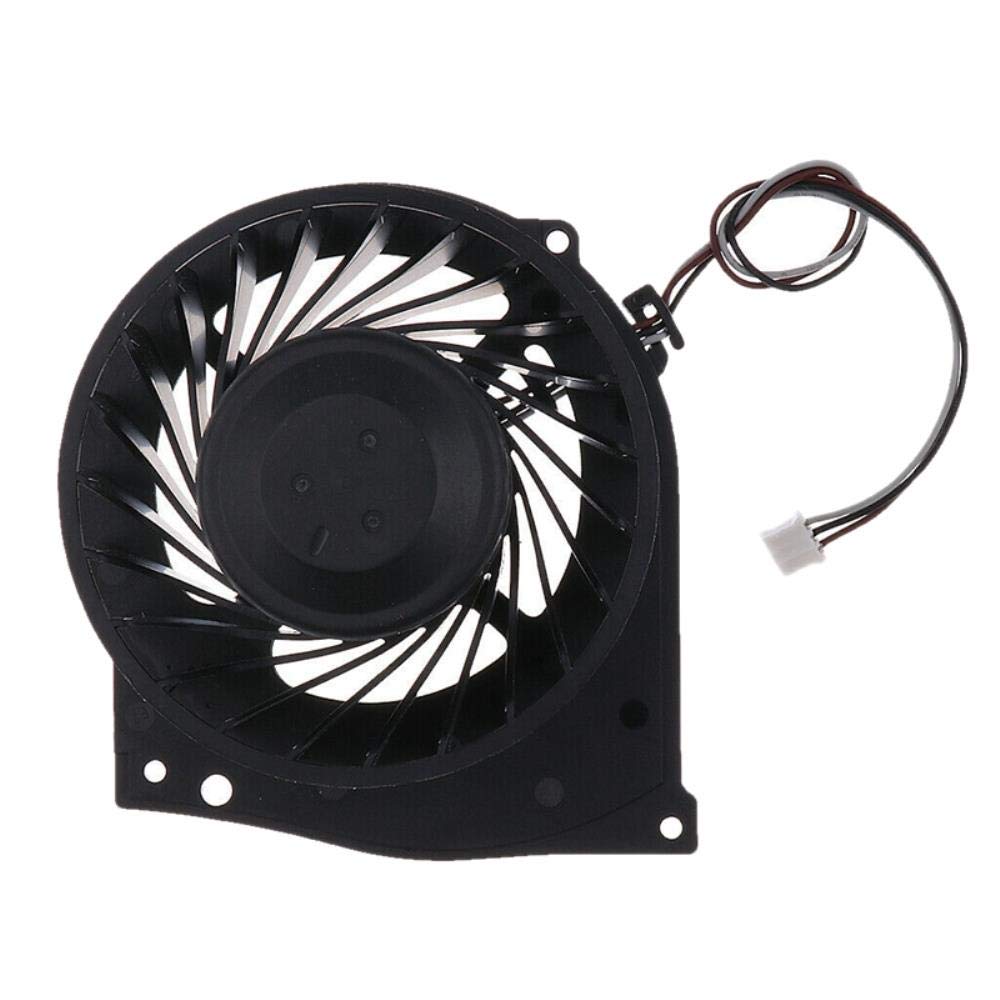PlayStation 3 Super Slim WiFi Antenna Replacement
Duration: 45 minutes
Steps: 24 Steps
Dive into the PlayStation 3 Super Slim Teardown to uncover the secrets of this sleek gaming machine and get acquainted with the motherboard’s inner details. Feeling adventurous? You’ll find the antenna replacement steps kicking off at Step 19. Let’s get your console back in action!
Step 1
– Get ready to unleash the awesomeness of the PlayStation 3 Super Slim! This compact powerhouse is packed with impressive specs, including:
– Crystal-clear HD output in 1080p, 1080i, 720p, 480p, and 480i – yes, it’s a visual treat!
– Immersive audio with LPCM 7.1ch surround sound, Dolby Digital, Dolby Digital Plus, Dolby TrueHD, DTS, DTS-HD, and AAC – your ears will thank you!
– The powerful Cell Broadband Engine, because who doesn’t love a little extra oomph?
– The RSX GPU, handling graphics like a pro!
– 256MB XDR Main RAM and 256MB GDDR3 VRAM, giving you the speed you need
– And to top it all off, you’ve got storage options: 12GB (flash memory), 250GB, or 500GB (and it’s upgradable, yay!) – plenty of room for all your favorite games and more!
Step 2
– Not that we’re complaining, but we scored our PlayStation 3 Super Slim as part of a bundle deal. After countless epic adventures, it seems Nathan Drake finally uncovered some treasure worth talking about!
– So, what’s inside this bundle? Glad you’re curious:
– A slick 250 GB PlayStation 3 Super Slim system
– The classic DualShock 3 Wireless Controller
– An AV Composite Cable (no HDMI cable included in the lineup, unfortunately)
– An AC Power Cord to keep that energy flowing
– A USB Cable for juicing up the DualShock controller whenever needed
– Uncharted 3: Drake’s Deception (Game of the Year Edition) + Dust 514, complete with downloadable content.
Step 3
– We were curious to see how the PS3 Super Slim measures up to its predecessor, the Slim model—the console it’s replacing.
– Well, guess what? The results were pretty much what we figured! The Super Slim might have picked up a grander name, but it’s absolutely trimmed down in size.
– The two consoles may look like cousins from the back, but these similarities actually reveal some big updates for the Super Slim.
– First up, the cooling vents are noticeably smaller, probably because the fan itself is smaller and doesn’t have as much heat to handle.
– Also, the port layout is just a tiny bit different, which brings us to a question folks often ask about motherboard compatibility: Nope, you can’t swap the motherboards between Slim and Super Slim. They’re not that interchangeable.
Step 4
– One of the most talked-about changes in the new model—and a point of contention for many users—is the switch to a manual top-loading disc drive. It’s a bit of a head-scratcher, right?
– We think the decision to ditch the tray was likely made to save on costs and make the Super Slim even sleeker. However, this design choice has drawn quite a bit of criticism, reminding us of another recent trend in size-conscious design.
– Not only does this change help Sony’s bottom line, but it also sets the PS3 up for the future. When the PlayStation 4 finally makes its grand entrance, you can bet the PlayStation 3 Super Slim will still be hanging around, but at a much friendlier price.
– Just a heads up—the door is made of thin, somewhat flimsy plastic, which means you’ll need some overhead space to swap out discs. So, no more squeezing the PS3 into that tiny shelf!
Step 5
– The bottom of the Super Slim keeps things simple and familiar, but it’s missing the Wi-Fi indicator light. No need to fret though—Wi-Fi is still fully functional, so you’re not losing any connectivity superpowers!
– The front of the Super Slim still holds its charm with two USB 2.0 ports, a hard drive indicator light, and a lineup of logos. Yep, you’ve got your Blu-ray Disc logo and others to show off what this device can handle!
Step 6
Just a heads up, you’ll need one Phillips screwdriver and about 5 to 10 minutes to swap out that hard drive. Easy peasy!
– The PS3 Super Slim’s hard drive bay cover pops off effortlessly, revealing a bright blue Phillips screw waiting to be unscrewed.
– Once you remove that screw, the Hitachi TravelStar Z5K320 2.5″ SATA II 3.0Gbps 250 GB 5400 RPM hard drive slides out like butter. Smooth, right?
– Here’s the coolest part: Sony makes it super easy to upgrade your PlayStation’s hard drive. Grab any 2.5″ laptop hard drive—no weird firmware or funky enclosures needed. It’s just you, your console, and as much storage as your gaming heart desires.
Step 7
– Three of the outer case screws are hidden under small rubber feet, which not only keep the PlayStation 3 Super Slim stable but also give it a neat look.
– Blocking the fourth screw, there’s a Warranty Void sticker standing in your way. But no worries—off it goes!
– These little rubber feet aren’t much trouble to deal with; they’re easy to remove, add some grip, and keep the console looking sharp.
– As for the sticker—let’s be real, stickers like this are unnecessary, and we’re not fans. You probably aren’t either.
Step 8
– Grab a plastic opening tool to breeze through those outer bezels like a pro.
– Underneath the front outer bezel, you’ll spot the intriguing laser warning sticker just waiting to be discovered.
– Taking off the bezels not only reveals the screws we need to tackle but also opens the door to the inner workings of the Super Slim.
Step 9
– Alright, let’s dive in! What exciting discoveries await us inside the PS3 Super Slim? The only way to uncover the secrets is to gently slide the top cover aside.
– It seems like the internal plastic casing is giving a cozy hug to nearly every component.
Step 10
– Once you’ve popped off the top cover, let’s dive deeper by taking out the manual top-loading disc tray.
– Love it or hate it, the tray-free disc loader in the Super Slim is definitely designed with repairs in mind.
– Keep an eye out for the laser lens, which is marked as KEM-850 PHA 0672 23020A.
– We’ve come across some mixed reviews about the noise levels from the PS3 Super Slim’s disc drive, so we made sure to check out Sony’s noise reduction efforts:
– The drive is cushioned on super soft rubber bumpers and encased in a noise-dampening plastic tray, which should help reduce vibrations.
– That said, it might not do much to quiet the sounds coming directly from the drive through the thin plastic tray door.
Step 11
– You can pop out the power supply module from the back of the case without much hassle.
– Although the component layout is pretty tidy, getting inside the power supply itself is a bit of a challenge. It’s held together by four screws and some seriously tough plastic clips.
– Similar to the PS3 Slim, the power supply is built to handle inputs ranging from 100V to 240V AC, so it’s travel-ready for globe-trotting adventures.
– Looks like they’ve trimmed down power consumption too. While the PS3 Slim was rated at 12 V and 18 A DC, this Super Slim is rocking 12 V and 13 A DC.
Step 12
– Let’s get that motherboard and fan assembly out of the lower case as we dive into this adventure.
– We were a bit surprised to discover that the whole motherboard assembly needs to come out to reach the fan or heat sinks, but hey, it does create a sleek and sturdy design.
– On the front of the fan assembly, we spot the Wi-Fi and Bluetooth antennas.
– Etched onto the antennas is the logo for TE Connectivity. According to them, their “antenna designs have been used in a variety of wireless products, including… groundbreaking gaming consoles.”
Step 13
– Behind door number two…the motherboard awaits!
– After a few suspenseful moments, the metal frame gracefully lifted off, revealing the motherboard.
– A quick once-over shows the GPU is well taken care of with thermal paste, but the CPU? Let’s just say it’s got room for improvement.
– Got perfectionist vibes? There’s an opportunity to make it better and keep those techie hands happy!
Step 14
– Time to get up close and personal with the PlayStation 3 Super Slim’s brain – let’s flip the motherboard 45 degrees and meet the key players behind its processing power!
– Cell Broadband Engine CXD2996BGB – the main event!
– Hynix H5RS5223DFA 512 Megabits GDDR3 VRAM – and not just one, but four chips that add up to a whopping 256 MB!
– Sony CXM4027R MultiAV driver – the one that makes it all work together
– Panasonic MN8647091 HDMI transmitter – bringing you crisp, clear video
– Elpida X1032BBBG-3C-F 1 Gb (times two for 256 MB total) XDR DRAM – because who doesn’t love a little extra memory?
Step 15
– Ready to dive into some motherboard magic? Keep an eye out for the following microscopic champions hanging out on the top of the board:
– Sony RSX CXD530, also lovingly known as the ‘Reality Synthesizer’—what a name, right?
– Marvell Avastar 88W8781 SoC WLAN/Bluetooth chip, bringing you wireless everything.
– Sony CXD9963GB, the I/O bridge controller keeping all those connections smooth as butter.
– Macronix MX29GL128FLT2I, making flash storage look easy.
– Sony CXD5132R, your trusty SATA/PATA Blu-ray drive controller buddy.
– And finally, the integrated Wi-Fi antenna PCB for all your speedy internet needs. It’s tiny but mighty!
Step 16
– Alright, flip this baby over to the other side—it’s time for some quick tweaks:
– SW3-302 SCEI 1220EM42E needs your attention here. Handle it like a pro!
– BD7761EFV 227 T25 requires a little finesse—do your thing.
– Intersil ISL6332 MDRZ H223BCC is up next. Stay cool and steady.
– IDT 4227ANLG 1149L is your next move—easy does it.
– Finally, Texas Instruments TPS53123 gets its spotlight. Work those controller vibes!
Step 17
The Super Slim has definitely shed some bulk and slimmed down that fan compared to the Slim version.
– The Super Slim starts to feel a bit toasty as we carefully take out the squirrel cage fan and two heatsinks.
– In this (possibly final?) version of the PS3, Sony has harnessed some snazzy tech to shrink the console down, making it lighter and quieter, while keeping performance improvements on the down-low.
Step 18
– PS3 Super Slim Repairability: It’s a solid 7 out of 10—pretty chill to fix!
– The hard drive is a total breeze to reach, fix, or upgrade—score!
– That modular, tray-free disc loader is like your best buddy—super easy to swap out when needed.
– Standard tools work like magic here, although you’ll need a T8 Security bit, which isn’t too wild.
– Heads-up: there’s a cheeky little ‘Warranty Void’ sticker, but don’t let it spook you—it’s mostly harmless.
– The power supply’s got an extra layer of protection with all those clips, but honestly, internal fixes for it should be rare.
– To check out the fan or heat sinks, you’ll need to super politely evict the entire motherboard assembly.
– The sliding disc tray door has some attitude—might feel a little wobbly and could break if you give it a lot of tough love.
Step 19
– Pop off those rubber feet from the bottom of the console—don’t be shy, they won’t bite!
– Uncover the screws hiding under the rubber feet, and don’t forget the sneaky one hiding under the warranty sticker.
Step 20
– Grab your trusty flat-head screwdriver and pop those security screws off the side—easy peasy!
– Slide off the side cover and gently unclip the front flaps. You’re doing great, keep going!
Step 21
– Unscrew those two little screws from the disk tray to lift off the top. You’ve got this!
Step 22
– Keep that disk tray in place! Just give it a gentle lift to uncover the screw securing that side of the power board.
– Next up, carefully take out the power assembly to access the Bluetooth and wireless connections. You’re doing great!
Step 23
– Detach the wireless aerial from the motherboard so you can swap it out for a toggle antenna. Let’s get this done!
Step 24
– Drill a hole for the toggle antenna right through the top of the console and the flap. Nice and steady does it—you’re making progress like a pro!












































